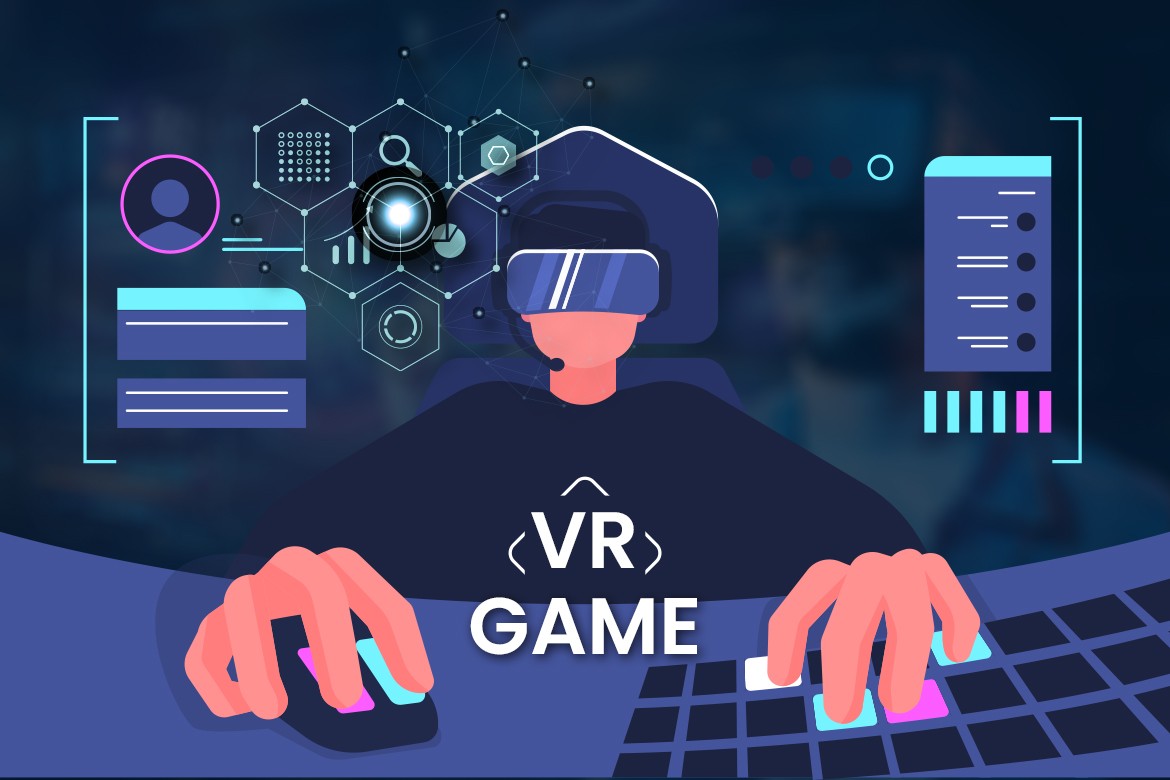
Tips to Start with Virtual Reality (VR) Game Development – BR Softech
Virtual Reality game development is becoming one of the fastest-growing verticals of the technological industry. It is gradually becoming one of the best investment opportunities. Major tech giants like Facebook, Google, Microsoft, etc. are making great strides in the VR industry. Moreover, companies like Samsung and Sony are working towards designing VR devices in an attempt to make Virtual reality hardware more affordable and accessible for the general public.
Affordable VR hardware like VR equipment and consoles are ushering in a new era of VR game development. New and updated VR devices are entering the market every year. Moreover, developers are looking to develop virtual reality application versions of their popular game titles to engage a new demographic audience.
This blog will highlight VR software development and a step-by-step guide on how to develop cutting-edge VR games.
What is a VR Game?
Any video game that uses virtual reality technology to deliver a highly-immersive experience to the user is called a VR Game. These games are designed to transport the user into an immersive virtual reality environment where they can interact with virtual objects. However, in order to play virtual reality games, a player needs VR equipment like HMDs, VR glasses, or VR consoles.
With the help of VR Game development software like Unity 3D and Unreal Engine, there have been massive strides in the field of Virtual Reality software development. The advent of advanced technologies has been integral in facilitating VR development. Let’s take a look at the market overview of the VR industry.
Get Free VR Game Demo
We have a team of experts who can help you in app web & software development
VR Game Development: Market Overview
According to Fortune Business Insights, the global virtual reality game development market was valued at $6.2 billion in 2020. In 2021, it was estimated to be worth $7.9 billion. It is expected to grow at a CAGR of 31.4% during the forecast period(2021-2028). The projected market value of the VR gaming market is $53.44 billion by the year 2028.
The market for virtual reality technology is gradually expanding. Other than gaming, it has penetrated a number of industries including e-commerce, fashion, etc.
The widespread use of the VR market has urged mobile game developers to come up with new strategies to facilitate VR application development. Developing a VR game is not an easy task, it requires immense knowledge of programming languages and the latest technologies. Not to mention, the development cost is staggering considering how expensive VR equipment is as of now.
VR Game Development: Step-by-Step Guide
Developing VR games is an intricate and time-taking process that requires a fair understanding of development technologies and programming languages. Let’s take a look at the step-by-step guide for VR game development-
1. Come Up With An Unique Idea
First and foremost, if you want to develop virtual reality applications, you need to come up with a unique game idea. You also need to specify the target audience of your VR game. Make sure to also prepare a game design document(GDD) to share with your development team in order to streamline the entire VR application development process.
2. Choose the VR Platform
After you have finalised your game idea, the next step is to choose the VR platform you want to target. Nowadays, there are a plethora of VR devices available in the market. You need to have a good understanding of these devices before you can start developing your VR Game. Oculus(Meta), HTC, and Valve are some of the leading manufacturers of VR equipment. Moreover, Google, Sony, and HP have also released their own VR devices. Here are the most popular VR devices that you can choose from-
Every one of these devices falls into 4 of these categories of VR devices that you should study thoroughly. Let’s take a look-
Console VR
PlayStation has come up with its own virtual reality platform called PSVR and PSVR 2. While the PSVR is compatible with PS4 and PS5, the PSVR 2 is only available for PS5. Moreover, the PSVR is also designed to be compatible with PlayStation Eye Camera, Move Controllers, and PS Dualshock Controllers.
Mobile VR
While the console platform is greatly dominated by Sony, there are a lot of competitors in the Mobile VR platform. While Google Cardboard is the cheapest option(only $10) to access virtual reality games, it has very limited functionalities.
Meta’s Oculus Quest 2 and Merge VR are two of the most premium mobile virtual reality devices that feature exceptional compatibility and functionalities which makes them the preferred choice of VR mobile game developers.
Standalone VR
Standalone VR equipment doesn’t require an additional device like a mobile or console to run Virtual reality games. These devices feature their own memory and processor to offer immersive VR experiences. Some of the most popular standalone VR headsets include-
PC VR
PC features one of the best virtual reality experiences. This is due to the fact that computers feature powerful processors and larger screens than mobiles. However, PC VR equipment is more expensive than mobile VR equipment. Still, if you want to deliver an immersive and out-of-the-box VR experience, PC might be the best platform for you. Some popular PC VR devices include-
3. Select the Graphics Style
After deciding on the platform, the next step is to determine the graphic style of your VR gaming development. However, keep in mind that this decision will greatly influence the development cost of your VR project. Generally, there are 4 options available-
2D
Although 2D is a little outdated, it is still widely used for game development. The primary reason is lower costs and better replayability. If executed properly, 2D graphics can offer an immersive and captivating user experience. If you are leveraging 2D Unity VR game development, you can either use in-house editors or outsource your project to a Virtual reality apps development company.
It goes without saying that 3D graphics offer a mesmerizing experience that is absent from 2D. Moreover, because it is widely used, it is a cost-effective option. Unity3D, Unreal Engine, and Autodesk Maya are some of the most prominent game engines used for 3D VR gaming development.
Photorealistic Graphics
Photorealism is the art of imitating a photograph. Developing a VR game with photorealistic graphics will certainly enhance the appeal of your VR game. However, it also significantly increases the cost and time of the development process.
Read More:- VR Poker- Virtual Features of Online Poker Platform
4. Select the VR Development Platform
The next step is to choose the VR Development Platform. Although there are a plethora of VR Development Software available in the market, the ultimate choice comes down to Unity or Unreal. However, it is important to take the benefits of both into account to make an informed choice. Let’s take a look-
Unity3D
Unreal Engine
According to our experienced development team, Unity VR Game Development is the best choice to develop highly responsive and cutting-edge VR games.
Define Your Development Budget and Select a VR Developer
The game developer is the heart of the development process. Therefore, the success or failure of your project greatly depends on the VR Developer you choose. Make sure to hire an experienced and skilled developer that has an in-depth understanding of virtual reality technology. An experienced VR developer will streamline the development process and also minimize the errors in development.
The overall VR Game development cost is dependent on multiple factors. In order to get an exact game budget estimate, you have to consider factors like the targeted platform, the complexity of the features, app size, graphics style, location of the developers, etc.
1. Develop a Minimum Viable Product
Now that you have all the necessities figured out, it is time to start the development phase. The first step is to create an MVP and collect feedback from it to further improve your game app. An MVP stands for Minimum Viable Product and it serves as a functional prototype of an application.
2. Launch & Deployment
After you have successfully developed your VR app, it is time to deploy it into the market so users can get their hands on it. There are different publishing platforms and each one of them has its own set of requirements that the game title must meet. Here are some of the most popular platforms for publishing VR games-
Read Blog: How AR, VR, XR, MR Are Dependent On Each Other?
How can BR Softech Assist You With Virtual Reality Game Development?
As a leading VR Game Development Company, BR Softech has been developing cutting-edge VR applications for multiple platforms. Our developers are well-versed in advanced technologies and use their expertise to develop hyper-realistic and responsive VR games. With over 12 years of experience, we are a pioneer in VR development and use our expertise to create innovative and out-of-the-box solutions for Virtual Reality apps. We offer-
If you want to leverage VR Development software, you can contact BR Softech.
Quick Contact Us :
Frequently Asked Questions
The cost to develop a VR game is dependent on many factors. On average, it costs around $30,000 to $40,000 to develop a VR game. However, if you want to develop a cross-platform game, the cost can go up to $50,000.
The cost to develop a VR game is dependent on many factors. On average, it costs around $30,000 to $40,000 to develop a VR game. However, if you want to develop a cross-platform game, the cost can go up to $50,000.
It takes around 3 to 5 months to develop a VR app from scratch.
It takes around 3 to 5 months to develop a VR app from scratch.
Yes, we offer completely customized virtual reality app development. Our customized solutions are bespoke and tailored to the client’s requirements.
Yes, we offer completely customized virtual reality app development. Our customized solutions are bespoke and tailored to the client’s requirements.
This content was originally published here.


